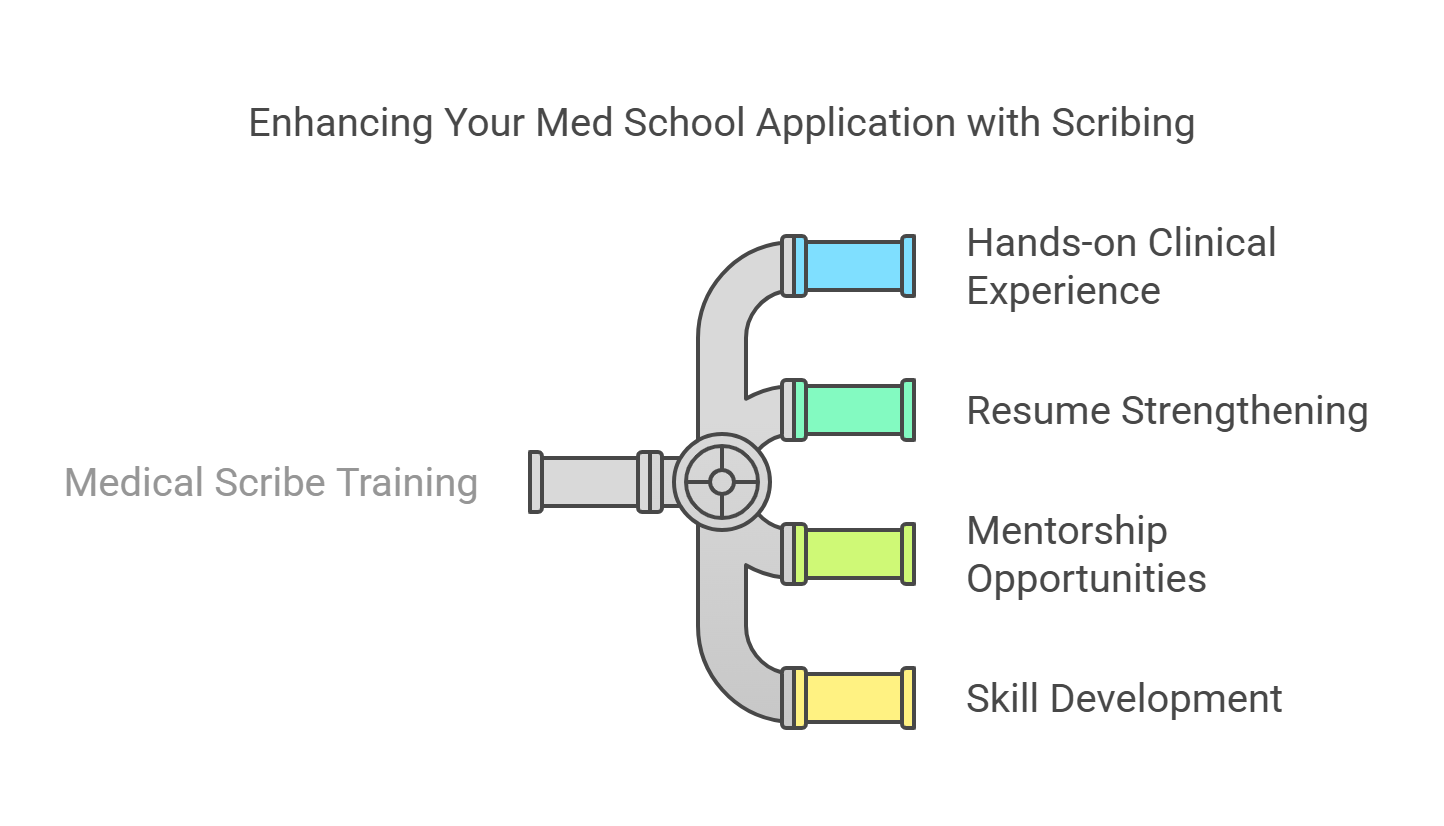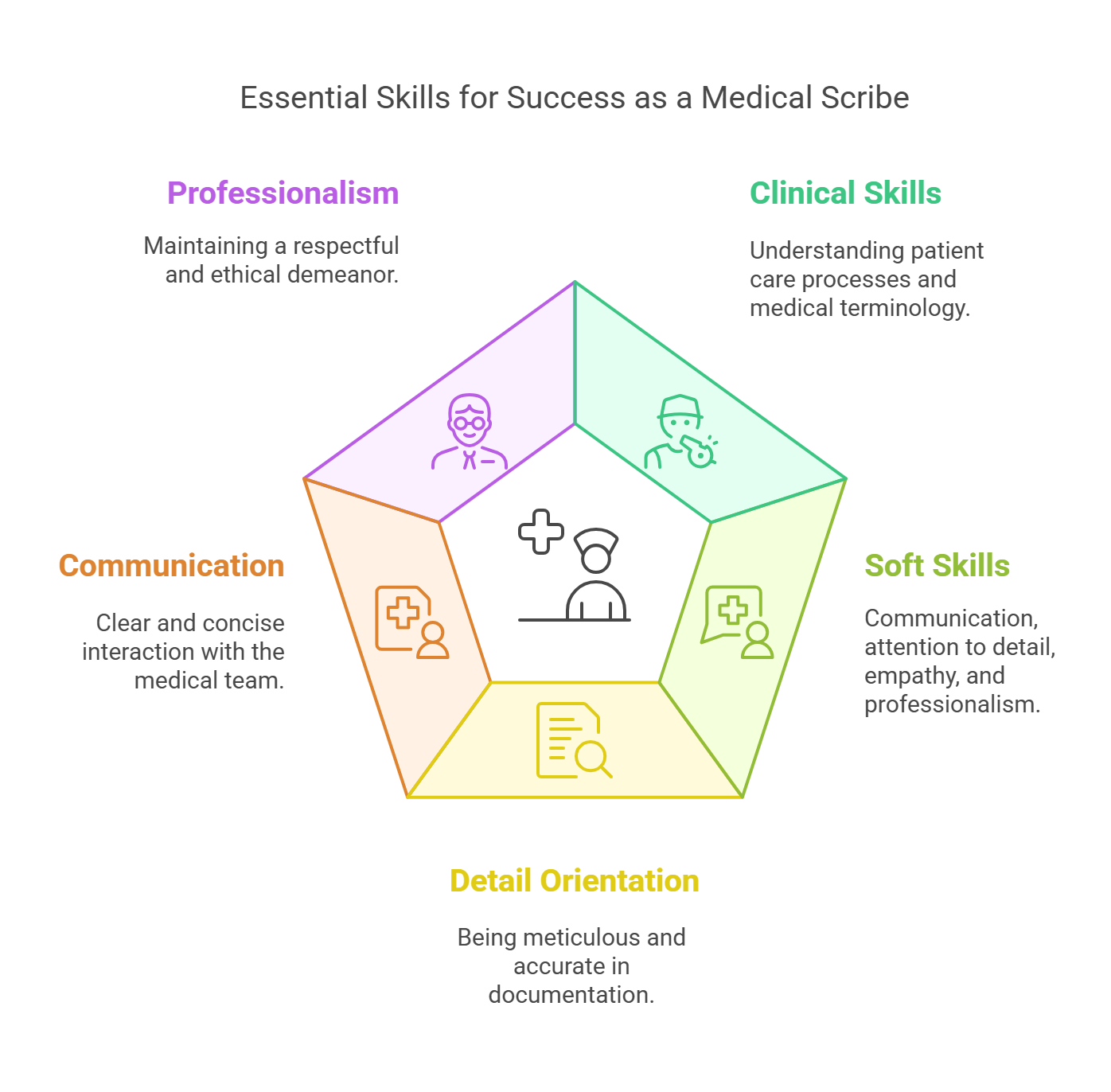Premed Med School Application
Aspiring medical students know how competitive medical school admissions are. One way to stand out is through hands-on clinical experience. Gaining patient interaction and real-world healthcare exposure is crucial—but how can you do this while managing academics?
A medical scribe training program could be the answer. It offers a unique chance to work alongside physicians, observe patient care, and develop skills essential for medical school and beyond. Whether you want experience, a stronger resume, or valuable mentorships, scribing provides a clear path to success.
This guide covers everything you need to know about medical scribe training—its basics, long-term benefits, and how it strengthens your medical school application. Let’s explore how this experience can shape your future in healthcare.
What Exactly Does a Medical Scribe Do?
Before we explore how medical scribe training can benefit premed students, let’s first understand the role of a medical scribe.
A medical scribe works directly with physicians and other healthcare providers, assisting with the documentation of patient encounters. As a scribe, your job will be to accurately document every detail of patient visits, including medical histories, symptoms, diagnoses, treatments, and follow-up care instructions. While you won’t be involved in direct patient care, your role is crucial in ensuring that patient information is correctly recorded, allowing healthcare professionals to focus on providing the best care possible.
Some of the key responsibilities of a medical scribe include transcribing patient notes during consultations, managing electronic health records (EHR), assisting with the organization of patient files, and maintaining confidentiality throughout. Additionally, you'll observe doctors and other medical professionals as they interact with patients, which provides valuable insight into medical practices.
In short, medical scribes play a vital role in healthcare teams by ensuring that documentation is handled efficiently and accurately, thus enabling healthcare providers to concentrate on delivering excellent patient care.To understand more about medical documentation and the role of electronic health records (EHR), visit the National Institutes of Health (NIH):
The Benefits of Medical Scribe Training for Premed Students
Medical scribe training is one of the most valuable experiences you can pursue as a premed student. As you navigate the competitive medical school application process, certain qualities and experiences can help you stand out. Medical scribing is one such experience that checks multiple boxes—gaining clinical exposure, understanding the healthcare environment, and developing skills that medical schools value highly.
Here are several key benefits of becoming a medical scribe:
Gaining Hands-On Clinical Experience
For many premed students, shadowing physicians or volunteering at hospitals may seem like the most common route to gaining clinical experience. While these opportunities provide some exposure, they often do not offer the in-depth involvement that comes with being a medical scribe. As a scribe, you will work directly with physicians and other healthcare professionals in a clinical environment, documenting patient information, observing diagnoses and treatments, and learning about the medical decision-making process firsthand.
This hands-on experience not only helps you understand patient care, but it also enables you to become familiar with medical terminology and practices. You'll see the day-to-day operations of a medical office, which is crucial for anyone planning to pursue a medical degree. This type of experience is highly regarded by medical school admissions committees, as it demonstrates your commitment to medicine and familiarity with clinical settings.
Building Professional Relationships and Networking
Being a medical scribe gives you the unique opportunity to build strong, professional relationships with healthcare providers, including physicians, nurses, and other members of the medical team. These relationships can lead to invaluable opportunities in your medical career.
Networking is a crucial part of professional growth in the medical field. During your time as a medical scribe, you may gain access to shadowing opportunities with specialists in areas of interest, obtain letters of recommendation for your medical school application, and even develop long-term mentorships that can guide your career.
Strengthening Your Medical School Application
One of the key factors that medical school admissions committees look for is an applicant's clinical experience. While academic success is important, hands-on experience in a healthcare setting shows that you are committed to medicine and understand the demands of the profession.
Medical scribe training provides an excellent way to demonstrate both. By becoming a scribe, you'll be able to show admissions officers that you not only have a strong academic background but also the practical experience that will allow you to thrive in medical school. The ability to document patient visits, understand medical terminology, and communicate effectively with healthcare teams makes you an appealing candidate for any medical school.
Developing Crucial Clinical and Soft Skills
Medical scribes acquire a wide range of skills that are essential for success in medical school and throughout a healthcare career. To learn more about the necessary steps, key skills, and certification requirements, check out our comprehensive guide on becoming a medical scribe.
These include clinical skills like understanding patient care processes, familiarity with medical terminology, and a deeper knowledge of healthcare practices. But there are also essential soft skills that you’ll develop, such as communication, attention to detail, empathy, and professionalism.
As a scribe, you'll be expected to be detail-oriented, work under pressure, and communicate clearly and concisely with the medical team. These skills are vital for medical students who will need to navigate complex clinical scenarios and patient interactions effectively.
To understand the role of medical scribes in compliance and documentation, visit Centers for Medicare & Medicaid Services (CMS):
Gaining Exposure to Different Medical Specialties
One of the greatest advantages of becoming a medical scribe is the wide variety of medical specialties you’ll be exposed to. Depending on where you work, you may have the opportunity to observe different types of medical practices, from family medicine to emergency care, dermatology, cardiology, and more. This exposure helps you decide which specialty you might want to pursue and provides insights into various aspects of healthcare.
How Becoming a Medical Scribe Can Shape Your Future in Medicine
The medical field is complex, fast-paced, and requires a high degree of precision. As a medical scribe, you’ll experience this firsthand, assisting physicians and medical teams while gaining practical experience in patient care and documentation. This immersion helps premed students not only develop technical skills but also adapt to the fast pace of medical work.
Building Empathy and Communication Skills
As a scribe, you'll regularly interact with patients, observe their interactions with physicians, and gain insight into their emotional and psychological needs. This exposure is invaluable for developing empathy and communication skills, which are essential for any medical professional. The ability to communicate effectively with patients and colleagues alike is crucial for building trust and delivering high-quality care.To understand how medical scribes play a vital role in improving patient communication, read our detailed guide on Enhancing Patient Communication: Role of Medical Scribes.
Table: Key Differences Between Shadowing and Becoming a Medical Scribe
By becoming a medical scribe, you not only gain invaluable skills and experience but also pave the way for a successful medical career. Don't wait—consider medical scribe training as your next big step toward achieving your dream of becoming a physician.
Conclusion: Is Medical Scribe Training Your Path to Medical School Success?
If you're looking for a way to stand out in your medical school application, become more immersed in the healthcare field, and develop crucial skills, then medical scribe training is an excellent choice. This experience offers you the opportunity to gain hands-on clinical exposure, build valuable relationships, and enhance your overall qualifications.
Medical scribing may be one of the most strategic steps you can take on your journey toward becoming a physician or a clinical trial manager. It provides real-world insights into healthcare, strengthens your application, and prepares you for success in both medical school and a career in medical research and clinical trials.
If you’re serious about pursuing a career in medicine, don’t underestimate the power of medical scribe training. It could be the key to unlocking your future in healthcare.
FAQ’s
How Long Is Medical Scribe Training?
The duration of medical scribe training can vary depending on the program you choose and the organization offering it. Typically, the training process lasts anywhere from two weeks to a couple of months, depending on whether you’re learning through a formal course or an on-the-job training program.
Some medical scribe programs are quite intensive and may involve classroom-based instruction, online modules, or simulations of real-world medical scenarios. These programs are designed to ensure that you have a solid understanding of medical terminology, documentation procedures, and the tools required for efficient scribing.
Once you complete the initial training, you’ll be expected to undergo a period of hands-on practice, where you'll shadow experienced scribes and gradually begin documenting patient visits on your own.
Is It Worth Being a Medical Scribe?
Absolutely! If you're a premed student looking to gain clinical experience, medical scribing is one of the best opportunities available. It provides hands-on exposure to real-life medical settings, enhances your understanding of patient care, and helps you build relationships that can lead to shadowing, mentorship, and strong letters of recommendation.
In addition to helping you stand out in your medical school application, being a medical scribe allows you to develop valuable skills that will serve you well in both medical school and your future career as a physician. You’ll gain practical knowledge, improve your communication abilities, and sharpen your clinical acumen—all of which will be beneficial throughout your medical journey.
Can You Be a Medical Scribe Without Training?
While it is possible to find some positions where you can begin working as a scribe without formal training, it is strongly advised to undergo medical scribe training before seeking employment. Most healthcare facilities and medical offices prefer to hire candidates who have completed a structured training program, as it ensures you’re familiar with medical terminology, documentation processes, and patient confidentiality.
Additionally, formal training helps you learn the essential tools and technologies used in medical scribing, such as Electronic Health Records (EHR) systems. It also ensures that you're prepared to handle the demands of the role and maintain accuracy in documenting sensitive patient information. Without proper training, you may find it difficult to keep up with the fast-paced, detail-oriented nature of the job.







